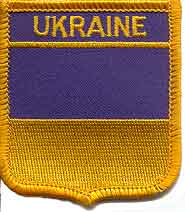

| Ukraine |  |
|
|
Kiev, Ukraine, USSR - June 1990 V. Blitz We arrived in Kiev, after an evening flight out of Moscow, and a long bus ride in the dark. It was midnight when we checked into our rooms. The rooms weren't much but I'd rather 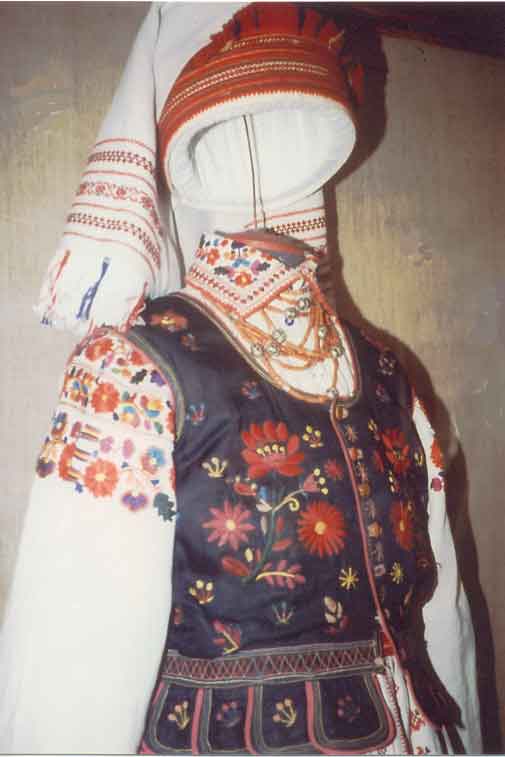 have a good-night's sleep than a pretty room any time. We were only there for two days but we had a good experience with great meals and the people were kind and friendly. There was a lot of dark humor about the near-by
Chernobyl atomic plant melt-down there but the people seemed to be keeping an up-beat attitude. After all, during World War
II the Ukraine lost
5 million people of the 27 million people killed in the entire USSR and one gets the impression that they take pride in their strength. have a good-night's sleep than a pretty room any time. We were only there for two days but we had a good experience with great meals and the people were kind and friendly. There was a lot of dark humor about the near-by
Chernobyl atomic plant melt-down there but the people seemed to be keeping an up-beat attitude. After all, during World War
II the Ukraine lost
5 million people of the 27 million people killed in the entire USSR and one gets the impression that they take pride in their strength.Quoting from the travel brochure: "First mentioned in Russian chronicles in the year 860, Kiev rivaled Rome and Constantinople for nearly 300 years as the capital of the East Slavic state of' Rus'. Though heavily damaged during World War II, Kiev was quickly rebuilt and many of its architectural and historic monuments preserved." It is funny what little things will stick in my mind, but here is one. In the restaurant of our hotel 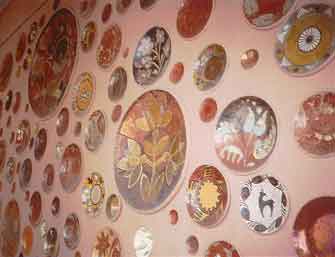 where we had most of our meals during our stay, was the most interesting wall. They had a collection of beautiful ceramic plates, plastered right into the wall. I had never seen that done before nor since and it was so unique and beautiful that I took pictures of it and considered doing the where we had most of our meals during our stay, was the most interesting wall. They had a collection of beautiful ceramic plates, plastered right into the wall. I had never seen that done before nor since and it was so unique and beautiful that I took pictures of it and considered doing the
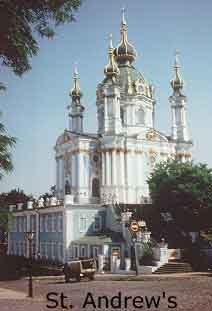 same to one of my walls when I returned home. Then it hit me just how expensive that would make that one wall and dropped the idea. same to one of my walls when I returned home. Then it hit me just how expensive that would make that one wall and dropped the idea.Our city tour took us to the Kiev Monument to Friendship, the lovely 18th century St. Andrews Cathedral and a high point overlooking the city and its broad and beautiful Dnieper River. But then we visited St. Sophia. St. Sophia was built in the 11th century by Yardaslov the Wise. One of his 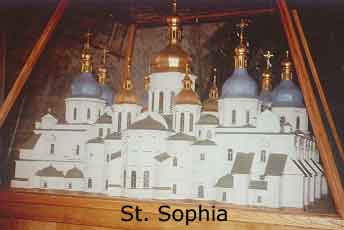 daughters married the King of Norway, another married the French King and a third married the Hungarian King. We weren't told about the fourth daughter. During WWII the Nazis turned St. Sophia into a stable, which is probably what saved this
magnificent structure from being destroyed like the other churches in the city. There was no way to get a picture of the entire "church" because of its size but my picture of this model will give one an idea of its enormity and beauty. daughters married the King of Norway, another married the French King and a third married the Hungarian King. We weren't told about the fourth daughter. During WWII the Nazis turned St. Sophia into a stable, which is probably what saved this
magnificent structure from being destroyed like the other churches in the city. There was no way to get a picture of the entire "church" because of its size but my picture of this model will give one an idea of its enormity and beauty.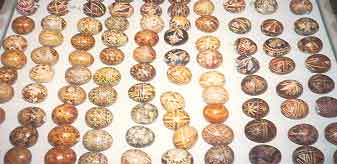 The area is renown for its hand-painted eggs. They say there are no two alike and they are such a work of art that one of the museums had hundreds of them in glass cases. So when I came across them for sale at the St. Sophia gift shop, I bought 14 of them to take home as gifts. Those real eggs had black backgrounds with
gaily colored designs on them. I was so pleased with my purchase because they were small, easy to pack, and I wouldn't have to be looking for any more gifts for the remainder of the trip. Wrong! Those real eggs had not been hard boiled and 2 or 3 would break each time we moved on to the next hotel so that by the time I arrived home, of the 14 eggs, there were only two or three unbroken ones remaining.
The area is renown for its hand-painted eggs. They say there are no two alike and they are such a work of art that one of the museums had hundreds of them in glass cases. So when I came across them for sale at the St. Sophia gift shop, I bought 14 of them to take home as gifts. Those real eggs had black backgrounds with
gaily colored designs on them. I was so pleased with my purchase because they were small, easy to pack, and I wouldn't have to be looking for any more gifts for the remainder of the trip. Wrong! Those real eggs had not been hard boiled and 2 or 3 would break each time we moved on to the next hotel so that by the time I arrived home, of the 14 eggs, there were only two or three unbroken ones remaining.
When the Nazis pulled out of Kiev, as they had done with Peter's Palace in St Petersburg, they stripped the Ukranian
Tsarist Palace o THINK GLOBALLY - ACT LOCALLY - PRAY FOR WORLD PEACE |